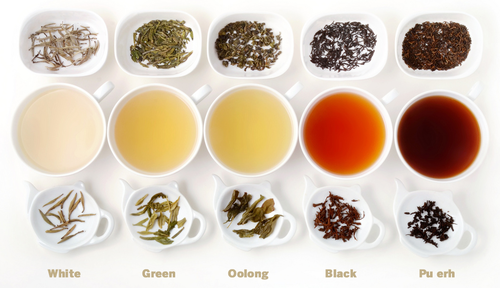The Role of Fermentation in Oolong Tea Production

In terms of tea production, oxidation and fermentation are often used interchangeably. However, beyond the world of tea, these are distinct chemical processes, with oxidation generally requiring air exposure while fermentation occurs when there's a lack of air (anaerobic).
Oolong tea fermentation (or oxidisation) is a crucial step that gives oolong its distinct properties that separate it from green tea and black tea. All of these teas originate from the same plant – the differences emerge in the way the leaves are treated post-harvest.
Going through multiple steps in preparation for a delightful cuppa, oolong tea is a labour-intensive process, but well worth the effort. But what makes oolong so unique?
What Is Oolong Tea?
Some teas achieve their distinctive flavours through the 'fermentation' process which technically oxidises the leaves. Green tea is minimally oxidised, giving it its earthy and fresh taste. Black tea, however, is fully oxidised giving a much deeper flavour and making it a good match for milk and/or sugar to offset that intensity. Oolong is oxidised to a level between these extremes, making it necessary to find the perfect balance between green and black for a distinct, layered, and instantly recognisable flavour profile.
Oolong has a long, colourful history with a particular cultural significance emerging in Taiwan, China, and later, Japan. Tea masters developed their craft over centuries, taking advantage of the perfect environmental and climate conditions for this tea to thrive. From the seventeenth century, oolong was even central to Britain's EIC trade system.
Over the years, new technology and scientific understanding have helped contribute to an amazing variety of oolong flavour profiles. This is no simple tea – this is art.
Oolong Tea Fermentation is a Crucial Step
Crafting the perfect cup of oolong takes time. The end result is determined as early as the initial harvest conditions - so traditional knowledge and wisdom play a huge role in harvesting at just the right time. From choosing leaves that are in peak condition for inclusion to choosing the timing with pinpoint accuracy, preventing accidental harvesting of leaves that are too mature or too young to oxidise in exactly the right way. Typically, however, oolong utilises leaves that are slightly more developed than the young, freshly grown leaves that give green tea its zingy freshness.
Oxidisation, or fermentation, begins immediately after harvesting as the freshly cut leaves start to react with the air. In small-scale productions, leaves are left to wilt in the open air. The tea producer will systematically alternate between exposure to sunlight and shade, to carefully develop the flavours and enhance the possible health benefits without compromising on the quality of tea produced. Then, the wilted leaves are shaken to bruise (traditionally in a bamboo drum, though there are more technological approaches available today). This bruising ruptures cell walls, allowing the chemicals and enzymes within to be released and continue the oxidisation process.
During this stage, tea masters keep a watchful eye over the oxidisation: too much will deliver black tea, while too little will result in a green tea. While both of these are excellent tea choices, neither is the desired oolong. It is during oxidisation that the chemicals in the tea leaves undergo change as exposure to enzymes breaks them down, turning them into a flavourful, health-supporting remedy.
Oxidisation continues into the rolling and shaping stage, which gives the tea leaves their distinctive appearance. The art of manipulating the leaves further crushes the remaining cell structures to release aromatic compounds. Finally, there is roasting and drying – though this step can be completed more than once depending on the desired intensity of flavour.
Crafting oolong is a patient process – and one that can take several years!
What Health Benefits Come from Oolong Tea?
Oolong undergoes a unique fermentation/oxidisation process, which helps catalyse the compounds in tea leaves into substances that are beneficial for your health.
For example, partial oxidisation helps produce a mix of powerful chemicals known for their antioxidant and anti-inflammatory properties. Antioxidants are utilised by your body to combat free radical damage while reducing oxidative stress. It's also thought that the compounds contained within oolong tea are beneficial for the proper function of the metabolism while enabling fat oxidisation to occur more efficiently than can be seen from other teas. As such, it may have the potential to assist in weight management by helping to oxidise fat into extra energy, while the polyphenols produced during fermentation may help balance blood sugar levels. On top of that, there are benefits to the heart through improved blood circulation and benefits to the brain as the presence of L-theanine boosts cognition, improves sleep, and reduces stress.
With its long and rich history in China, oolong has featured in traditional medicine as an accompaniment to meals to help aid digestion. More recently, there's been some research to suggest that oolong goes even further, also boosting heart health and improving cholesterol levels.
Oolong Fermentation Makes a Good Thing Even Better
Just like green tea, oolong does contain some caffeine – but not as much as coffee. Its heart, brain, and digestive benefits make it the perfect accompaniment to your afternoon lull. You'll feel more energised through the natural processes of fat oxidisation and efficient metabolic rates, and far less twitchy than after your Nth cup of coffee of the day.
All these benefits are contained in one little cup, and it's all thanks to the specialised, specific, and highly skilled oxidisation process that separates green tea and black tea from the harmoniously balanced oolong.
Would you like to give it a taste test for yourself? Order a sample from Teavision today to discover the place where great taste meets even better benefits.
- Lynn Wang
Comments 0